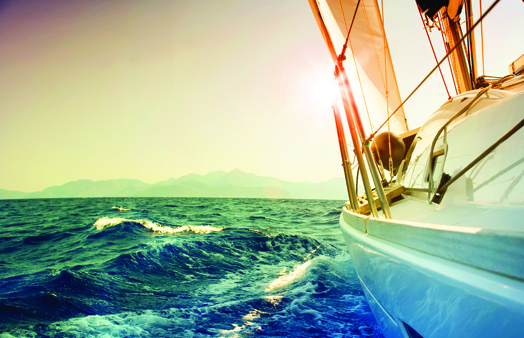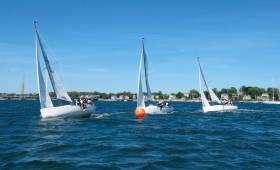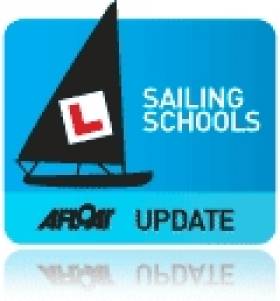Displaying items by tag: How to Sail
How To Make The Most Of Your J/70 In Light Airs
After a week of intense training with Japanese teams in Newport, Rhode Island, culminating with the New York Yacht Club One Design Regatta, a lot was learned about light air tuning and trimming.
Local skipper and North Sails pro Tim Healy made some useful notes on optimising the J/70 for speed in light air conditions — and you may find them applicable to similar sportboat classes.
Rig tuning
- Ease rig to get about 3/4 inch of middle side sag in the mast. This is done by going off two full turns on the uppers and off two turns on lowers. If you are not getting 3/4 inch side sag, keep easing lowers until you do.
- In big chop, use a little backstay to control the rig from excess movement. Just enough to control the rig but not too much to take out all headstay sag.
Sail trim
- In big chop and swell, keep speed up by twisting both sails thus making a large steering groove.
- Never stall the upper jib leech telltales. Trim until you see them stall then ease until 100% flowing.
- Jib leads 6-7 factory holes showing in front of jib car counting from behind front mounting bolt.
- Weather sheet trimmed to get clew at cabin house in flat spots, and 1.5-2 inches off in big chop and waves. Remember to move lead forward with less windward sheet and back with more windward sheet.
- Ease jib halyard to show 8-10 inches of wrinkles in luff of jib in light and choppy conditions.
- Main traveler up to get boom on centre when boat is up to speed out of tacks. Traveler at 75% up out of tacks for bow down acceleration.
Boat trim and turns
- Weight forward both up and downwind. Bow person in hatch up and down, out of hatch to help with roll tacking and gybing.
- Downwind: Tactician forward and to leeward and trimmer to weather. Both forward next to bulkhead.
- Upwind: Tactician forward next to bulkhead and trimmer as far forward as possible. Also, trimmer is first to control heel angle.
- Build speed first both up and down, then work on best VMG.
- Don’t let speed crash! It takes too long in light air to get going again.
- Make smooth turns and big rolls tacking and gybing.
- Keep momentum in focus when starting and at mark roundings
North Sails powered nine of the top 10 finishers at the NYYC One Design Regatta, including winners Team Vineyard Vines (John & Molly Baxter) and Tim Healy’s own USA 2 in second place.
Try Sailing, Kayaking & Paddleboarding For A Tenner
#trysailing – Alistair Rumball's Irish National Sailing School is holding its first Open Day this month at its base on Dun Laoghaire's West Pier with the aim of introducing newcomers to the sport. The Irish National Sailing and Powerboat School and the newly formed Irish National Sailing Club, will be opening its centre to the public on June 21st and you can try out Sailing, Kayaking, Paddle-boarding or Powerboating for just €10.
'We want everyone to be able to share in a sport that we love, sailing after all is a skill for life' Rumball told Afloat.ie.
Rumball, who featured recently in WM Nixon's Sailing on Saturday Blog, says he spent the winter 'investing in our fleet of boats and revamping our teaching syllabus, so much so that we are planning to put it all on display'.
The initative is part of the National Water Safety Awareness Week 2015 from Irish Water Safety, and in association with The Irish Sailing Association's Try Sailing initiative. Galway Bay Sailing Club held the West of Ireland's first " Try Sailing " launching in May, with up to 400 people getting on the water.
The Irish National Sailing Club will be on hand with its members and instructors to get as many people as possible on the water so they can experience a number of different water sports.
More information on the poster downloadable below or by emailing [email protected] or phoning 01 2844195.
Learning How to Sail is Easy, Once you Get Started!
#HOW TO SAIL – Just how many beginners who want to find out how to sail start out thumbing through the yachts for sale columns? If you're new to the sport of yachting it can be difficult to get started so there's a need to be smart about your approach. The good news is that to learn how to sail a boat you don't need to own one.
Because there are so many potential pitfalls in buying a boat (not least the fact you may for one reason or another end up not liking it) the most prudent idea is to keep your money in your pocket and plunge instead for a short learn to sail course at a yacht club or sailing school first.
This is a great way to put your toe in the water if you'll excuse the pun. It's a means of meeting like minded people, asking relevant questions, finding out more about sailing boats and classes but most of all it is a means of getting valuable tiller time on the basics of sailing. It involves no financial outlay other than the cost of a sailing course (see below) but offers a window to a sport that you (and your whole family) can enjoy together for the rest of your lives.
Many of the bewildering aspects of how to sail can be short-circuited within the safe environment of a sailing school or a sailing club. Experienced sailing instructors leave you free to enjoy the experience of getting afloat for the first time rather than dealing with the potential headaches of boat ownership on your own.
Ultimately then armed with a sailing certificate or at least some hands on knowledge you can look around at what's available to suit you, your family and your pocket in the boats for sale market.
Is it small boat sailing in Dun Laoghaire and Dublin Bay? Cruiser Racing in Cork harbour or just relaxing on a swinging on a mooring in the sunshine of Galway Bay? The great thing about sailing is the choice is so wide it caters for all.
Sail training and learning to sail courses come in many different formats from dinghy sailing to tall ship sailing. Courses have different types of accreditation. Some are devised by the Irish Sailing Association (ISA) and others from the Royal Yachting Association (RYA). Many of the estimated 100 centres and clubs offer certification from both.

Once you've mastered the basics you can explore new horizons
Sailing is not a pastime where you will learn the lot all in one go, so there's no need for cramming. Instead it's wise to start with a basic course and add new skills as you wish. As many Olympic helmsmen will tell you 'nobody knows it all in sailing'.
For many, learning the ropes can often lead to a rewarding career in sailing. Starting off as a competent crew can move on to sailing instructor qualifications and maybe a professional ticket that can be used working abroad in sailing holiday charter companies such as flotilla holiday crew or boat charter.
Learn to sail courses are operated around the coast by a network of sailing schools and clubs and for the 2012 season Bernadette Fox looked at what was on offer and picked out a selection of learn to sail in Ireland options from right around the coast.
HOW TO SAIL, WHERE TO SAIL
As the year unfolds and you start to think of new beginnings, why not let yourself be tempted to try sailing. Young or young at heart, extremely fit or just average, there is an option out there for you to try out some form of this sport.
Sailing boats range from colourful small craft to the larger yacht complete with galley and heads, that’s kitchen and toilet to landlubbers. In either case, the skills involved are very much the same. Learn to drive in a Mini and you should know how to drive a Porsche, or vice versa.
There are certified training courses available in training centres accredited by the ISA or the RYA. Certified courses progress you along a proven path from raw beginner to expert racing or cruising sailor. However, many training centres also offer courses that are more introductory in nature, designed to tempt you into this exciting world.
The Irish National Sailing School and Club with a fleet of 18 boats in Dun Laoghaire, Co Dublin offers a range of introductory options. Their three hour Taster Session for €69.00 is ideal for those going afloat for the first time. Stepping on board, the Instructor/Skipper will introduce you to your fellow sailors and by the time you are sailing out of the Harbour, you are part of the crew. For a group of friends or work colleagues, there are bespoke Group Offerings and believe me, an evening afloat on Dublin Bay after a hectic day in the office can be just bliss.
By contrast Heir Island Sailing School limits its numbers to just 21 sailors at a time. Heir Island is one of Carbery’s 110 Isles in Roaringwater Bay, off Skibbereen, West Cork and provides great sailing waters. A Bord Failte approved residential centre, Heir Island is popular with both families and groups of friends, many of whom return more than once. Be warned though, they book out quickly.
Almost next door is the Fastnet Marine and Outdoor Education Centre in Schull, Co Cork. Schull is a great holiday destination for families and despite its name, Roaringwater Bay provides sheltered waters for the novice sailor. Sign up for a full or half day on their 26-foot keelboat and receive a basic introduction to sailing. The day trips are suitable for groups or families and if the youngsters get hooked, there are week long sailing courses throughout the summer.
To splash about further west, the Dingle Sailing Centre in Kerry invites you to build your confidence on the water. If you are interested in getting afloat, there are both summer camps for children and opportunities for those more mature. Adult training courses are subject to demand but are tailored to suit your needs.
Meanwhile, if you are in Cork city, SailCork.com offers plenty of sailing in Cobh, Cork Harbour using their “tried and tested system” to introduce you to sailing. Their Taste of Sailing session costs €58 per person, €150 family or €99 for couples and according to their website, with their experienced instructors, provides a “blast”.
Close to Kinsale, Co Cork is The Oysterhaven Centre where you can sign up for their May Madness Taster Day; book any Saturday in May for e95 and you can bring a friend for free. Once you get hooked, you might even return, to stay in one of their holiday cottages overlooking Oysterhaven Bay, and really embrace Sailing.
Right in the heart of Kinsale is Sovereign Sailing operating out of the Trident Marina. If you are curious about sailing, for e45 euro per person, you can go yachting for a half day. Depending on conditions, like wind direction and strength, you sail to either the Old Head of Kinsale or around the Sovereign rocks. Along the way, under the skipper’s supervision, you can trim the sails and steer the boat; of course you could always just sit back and enjoy your surroundings.
While Kinsale is renowned for gourmet food, at Carlingford Sailing School your Skipper is not just an experienced Yachtmaster but also an award-winning chef. With a weekend introduction to sailing at just e395, this live-and-dine onboard experience is suitable for beginners. The pupil-to-teacher ratio of 5 to 1 is not exceeded so you will receive plenty of personal instruction. At night, the seven berth 36 foot yacht returns to the marina where the village of Carlingford beckons to those on a high following their time afloat.
Based in the nearby sailing club is the Carlingford Sail Training Centre who introduces all ages and abilities to the water. Their boats range from the responsive dinghy to the larger yacht. For €75 you sail along Carlingford Lough aboard one of their yachts on their Taste of Sailing Course. As they are also based in the Club if you are bitten by the bug you will soon meet other like-minded folk.
Closest to the village is the Carlingford Adventure Centre which includes sailing among their activities. As they can also provide comfortable accommodation the Centre is ideal for groups including hen or stag parties. No taxis required!
Lake sailing is another option, with the advantage of no salt or tides to consider. The University of Limerick Activity Centre is just outside Killaloe on Lough Derg. One day course for e100 provides a great introduction to the thrill of sailing. They will also tailor packages for groups, including hen and stag parties, which can also include other activities.
With Galway’s Bow Waves (www.bowwaves.com) you can choose to sail in either a dinghy or yacht. Dinghy sailing on Lough Atalia is great fun but it does require reasonable fitness and flexibility to pull yourself back into the boat after a capsize. For e65, all equipment, including wetsuits and life jackets are provided for the half-day session.
Visiting the sunny south east, Kilmore Quay, Co Wexford is perfect for a short break destination and the base of Sailing Ireland. A half day’s sail to the Saltee Islands, with its bird sanctuary and seal colony, is €50 per adult and includes a basic sailing lesson and the chance to helm the boat under instruction.
Professional but friendly is the tag line of Aquatrek Sea Skills, Youghal, Co Cork. If you have no prior experience, Aquatrek aims to make your sailing experience a challenging but never a dangerous one. Once you have mastered the basics you can continue to get on the water each Saturday for as little as €10, depending on the weather of course.
Try sailing – you might just get hooked, at the very least you can cross another activity off your “to do” list.































































